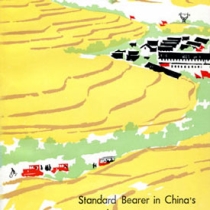Dazhai, modernity and self-sufficiency in the collectivised villages of Maoist China.

Published 2023-03-27
Keywords
- Dazhai,
- Collectivised villages,
- Production Brigade
How to Cite
Copyright (c) 2022 FAMagazine. Research and Projects on Architecture and the City

This work is licensed under a Creative Commons Attribution-NonCommercial-ShareAlike 4.0 International License.
Abstract
The essay explores facts and collective imaginary that marked the agricultural modernisation of the first decades of the People’s Republic of China (1949-1979) through the story of Dazhai village and its reconstruction. From the transformation of the landscape to the creation of services and spaces consistent with the new organisation of work and the associated life proposed by the Communist Party, the contribution follows the evolution and dissemination of models, guidelines, and rural interventions developed during Maoism. The essay concludes tracing the Maoist signs in the current Chinese policies of rural development.
References
- CAMMELLI S. (2016) – Storie di uomini e di fiumi. Lungo le rive del fiume azzurro cercando la Cina di ieri e di oggi. Il Mulino, Bologna.
- CHUNG J. H. (2016) – Centrifugal Empire, Central-Local Relations in China. Columbia University Press, New York.
- CIA (1971) – People’s Republic of China; Atlas. Central Intelligence Agency, Washington.
- DE GIORGI L. (2018) – “La propaganda internazionale della Repubblica Popolare Cinese: il periodo maoista”. Graziani Sofia (ed). Cina globale: soft power e proiezione internazionale, Sulla via del Catai - Rivista semestrale sulle relazioni culturali tra Europa e Cina, XI (18), Aprile 2018.
- GAVINELLI C. (1979) – “Cina, il nuovo paesaggio di Tachai”. Domus, 590, gennaio.
- GAVINELLI C., GIBELLI M. C. (1976) – Città e territorio in Cina. Laterza, Bari.
- HEILMANN S. (2008) – “From Local Experiments to National Policy: The Origins of China's Distinctive Policy Process”. The China Journal 59, 1-30.
- HINTON W. (1988) – “Dazhai Revisited”. Monthly Review, 39 (10), Marzo.
- KAO T. S. (1963) – “Rapporto di tipo nuovo tra città e le campagne in Cina”. Pekin Information, 4. Citato in Controspazio. Cina, Architettura e Urbanistica 1949-1970, 3 (12), 1971.
- KNAPP R. G. (ed.) (1992) – Chinese Landscapes. The Villages as Place. University of Hawaii Press, Honolulu.
- SCOTT J.C. (2009) – The Art of Not Being Governed: An Anarchist History of Upland Southeast Asia. Yale University Press, New Haven.
- SHAPIRO J. (2001) – Mao’s War Against Nature. Politics and the Environment in Revolutionary China. Cambridge University Press, Cambridge, UK.
- STRONG A. L. (1964) – The Rise of the Chinese People’s Communes – and Six Years After. New World Press, Peking.
- UNGER J. (2015) – The Transformation of Rural China. 2nd edn. Routledge, London New York.
- WORLD BANK (2022) – World Bank Open Data [online]. Available at: <https://data.worldbank.org/indicator/AG.LND.AGRI.ZS?end=2018&locations=CN&start=1961&view=chart> [Ultimo accesso 11 Giugno 2022]
- ZHAO C. (2007) – Socio-Spatial Transformation in Mao’s China. Settlement Planning and Dwelling Architecture Revisited (1950s-1970s). PhD Thesis, Ketholieke Universities Leuven, Leuven.
